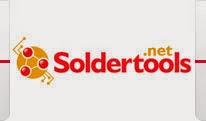By Bob Wettermann
There are a variety of different configurations of SMT stencils depending on the intended end usage. SMT stencils are used from prototyping a few boards to mass assembly of hundreds of thousands. Their usage and configurations are varied for a variety of reasons.
There are a variety of different configurations of SMT stencils depending on the intended end usage. SMT stencils are used from prototyping a few boards to mass assembly of hundreds of thousands. Their usage and configurations are varied for a variety of reasons.
 |
| Typical Framed SMT Stencil |
Prototype SMT stencils are used to build the first few assembled
prototypes of the PCB or they may be used to prove out a concept of only a
single function of a PCB. Typically the prototyping quantities are from a few
pieces up to 50 pieces for mass volume assemblers. These SMT stencils tend to
be “frameless” stencils in that they are held tautly to non-permanent frames.
“Foil only” or “frameless” SMT prototype stencils are foils with the
appropriate aperture patterns lining up to the locations on the PCB requiring
solder paste. These foil only SMT stencils can be manufactured from either
plastic (Kapton™) or nickel-based stainless steel alloys. Plastic stencils have
limitations on the size of the apertures and the distances between apertures
because the limited rigidity of the plastic is not as high of that of stainless
steel.
 |
| Kapton™ SMT Stencil |
In another derivative of this stencil “flaps” can be added to
the sides of the metal SMT prototype stencils which will help limited solder
paste flow to other areas of the PCB.
 |
| Prototype SMT Stencil with Flaps |
Another form of SMT stencils are frameless stencils. These are
used when there are many board “spins” requiring lots of different stencils or
when the PCB assembly area is space constrained. A single frame system has air
pressure applied to the frame system and therefore creates the tension on the
face of the stencil in order to create a quality print. These stencils are more
cost effective than framed versions as the frame is eliminated and the shipping
costs are reduced.
Finally, there are a variety of framed SMT stencil options which
are fit to a given machine configuration. The frames provide the rigidity and
the tensioning on the stencil. They come in a variety of different sizes and
materials. Older stencil printing machines have cast steel frames while more
modern stencil printing machines accommodate aluminum frames. Sometimes the SMT
stencil frames are color-coded for a variety of reasons including identifying
the alloy or solder paste versus adhesive versions.
